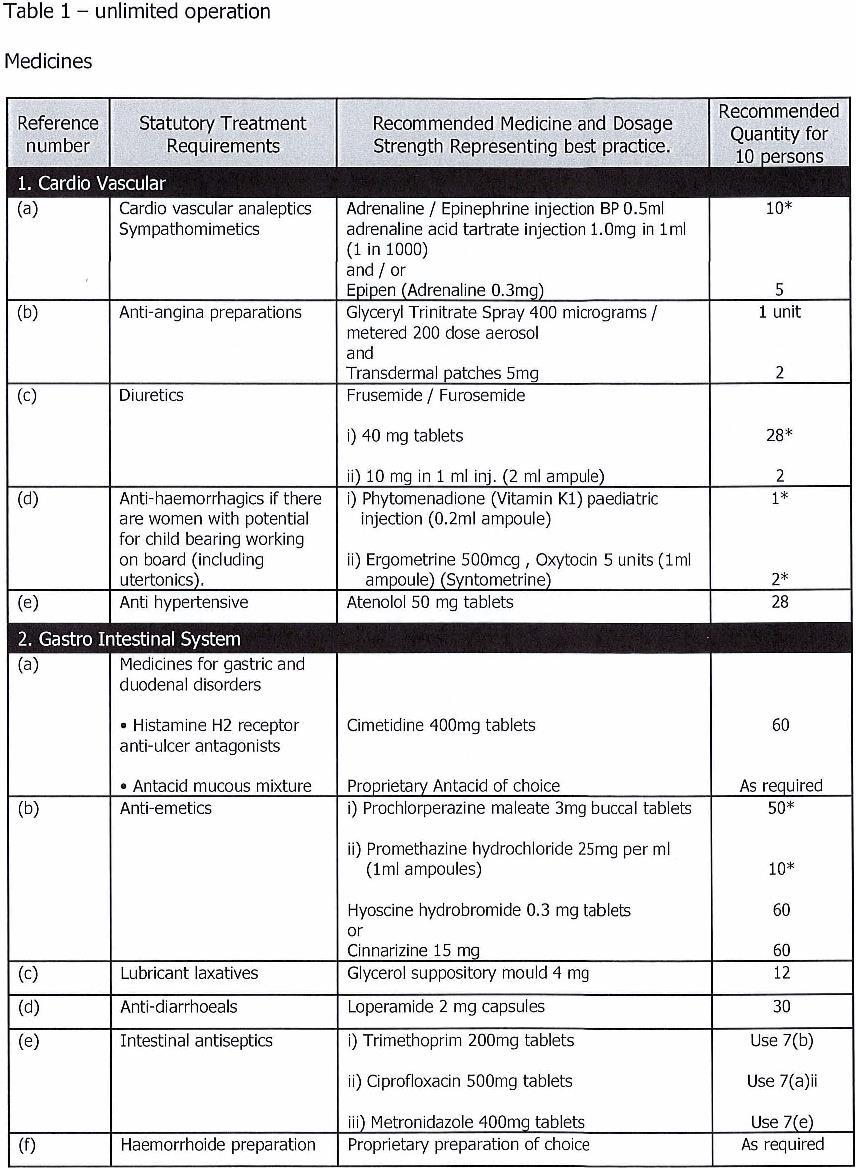
16 minute read
Navigational Equipment and Visibility from Wheelhouse
19
Navigational Equipment and Visibility from Wheelhouse
Advertisement
19.1 Navigational Equipment
19.1.1 A yacht should be fitted with the following: .1 A properly adjusted standard magnetic compass or other means, independent of any power supply, to determine the ship's heading . . 2 In a steel yacht, it should be possible to correct the compass for co-efficients B, C and D, and heeling error. .3 The magnetic compass or repeater should be so positioned as to be clearly readable by the helmsman at the main steering position. It should also be provided with an electric light, the electric power supply of which should be of the twin wire type.
19.1.2 A yacht should be fitted with, the following additional equipment: .1 An echo sounder; .2 A receiver for a global navigation satellite system or a terrestrial radio navigation system, or other means suitable for use at all times throughout the intended voyage, to establish and update the ship's position by automatic means; .3 A distance measuring log; .4 A gyro compass or spare magnetic compass bowl; .5 A rudder angle indicator; and .6 A 9 GHz radar.
19.1.3 For yachts of less than 300GT the equipment specified in 18.1.1 and 18.1.2 need not be of an approved type.
19.1.4 Means should be provided for taking bearings as near as practicable over an arc of the horizon of 3600 . This requirement may be met by the fitting of a pelorus compass, or, on a yacht other than a steel yacht, with a hand bearing compass.
19.1.5
For yachts under 300GT the requirements of 19.1.2.4 may be met by the use of a fluxgate compass, provided that a suitable back up power supply is available to power the compass in the event of failure of the main electrical supply. Where such a compass incorporates a capability to measure magnetic deviation by undertaking a calibration routine, and where the deviation figures are recorded within the device, a deviation card is not required.
19.1.6 Attention should be paid to magnetic effects on magnetic compasses, including fluxgate compasses, when operating in Polar Regions. (I.e. north of 70° N, or south of 70° S).
19.1.7 All yachts of 300GT and over shall be fitted with an approved automatic identification system (AIS) in accordance with SOLAS Chapter V. The AIS shall: .1 Provide automatically to appropriately equipped shore stations, other ships and aircraft, information including the ships identity, type, position, course, speed, navigational status and other safety related information; .2 Receive automatically such information from similarly fitted ships; .3 Monitor and track ships; and .4 Exchange data with shore- based facilities.
19.2 Bridge Visibility
19.2.1 Navigation bridge visibility should comply with SO LAS Chapter V, Regulation 22. Yachts under 45m in length should comply as far as reasonable and practicable.
19.2.2 Windows may be inclined from the vertical plane provided that, where necessary, appropriate measures are taken to avoid adverse reflections from within.
19.2.3 Windows to the navigating position should not be of either polarized or tinted glass (see 5.5.8) Portable tinted screens may be provided for selected windows.
20
Miscellaneous Equipment
20.1 Nautical Publications
Every yacht should carry nautical charts and nautical publications to plan and display the ship's route for the intended voyage and to plot and monitor positions throughout the voyage. An approved electronic chart display and information system (ECDIS) may be accepted as meeting these chart carriage requirements. Back-up arrangements to meet these functional requirements should be provided where this function is partly or fully filled by electronic means. This means single ECDIS and paper charts or duplicate ECDIS.
20.2
Measuring Instruments
Every yacht should carry a barometer. Every sailing yacht should carry an anemometer and an inclinometer.
20.3
Signaling Lamp
Every yacht should carry a daylight signaling lamp, or other means to communicate by light during day and night using an energy source of electrical power not solely dependent upon the ship's power supply. The signaling lamp may be the searchlight required by 20.4.
20.4
Searchlight
Every yacht should carry an efficient fixed or portable searchlight suitable for man overboard search and rescue operations.
20.5
Yachts of less than 150 GT require a radar reflector.
20.6
Yachts of more than 300GT must be marked externally with the yacht's IMO number which may be horizontal provided that it is visible from the air. The IMO number should also marked on part of the internal structure in accordance with SOLAS.
21
Anchors and Cables
The purpose of this section is to set out the minimum standard for anchoring and mooring arrangements. It should be noted that this element is to be an integral part of the Classification process and this should be reflected in the Class Notation or equivalent.
21.1 Equipment
21. 2
21.1.1
Yachts will be considered to have adequate equipment if fitted out in accordance with standards for such equipment, set by a Recognized Organization.
21 .1.2
Yachts not equipped in accordance with 21.1.1 may be specially considered by the Administration, provided full information is submitted for approval.
21.1.3 All yachts are to have at least two anchors, one of which must be ready for use at all times. Any powered deployment system should be connected to an emergency power supply or be capable of being manually operated.
Sailing Yachts
21.2.1
The sizing of anchors and cables for sailing yachts should take into account the additional windage effect of the masts and rigging.
21.2.2
Typically, for square rigged sailing yachts, experience based guidance on approximate increase in anchor mass and cable strength required is: • For yachts up to 50 meters in length, typically 50% above the requirements for a typical motor yacht having the same total longitudinal profile area of hull and superstructure as the square rigged sailing yacht under consideration; and • For yachts 100 meters in length and over, typically 30% above the requirements for a typical motor yacht having the same total longitudinal
profile area of hull and superstructure as the square rigged sailing yacht under consideration. For a square rigged sailing yacht of between 50 and 100 meters in length the increase should be obtained by linear interpolation.
22
Accommodation
22.1 General
22.1.1
An adequate standard of accommodation should be provided to ensure the comfort, recreation, health and safety of all persons on board.
22.1.2
Attention is drawn to the achievement of appropriate standards for means of access and escape, lighting, heating, food preparation and storage, messing, safety of movement about the yacht, ventilation and water services.
22. 1.3 Generally, accommodation standards for the crew should be at applied, wherever practicable, to the standards set by the International Labor Organization (ILO) conventions for crew accommodation in merchant ships. When it is neither reasonable nor practicable to site crew sleeping accommodation amidships or aft, and above the deepest waterline as required, measures taken to ensure an equivalent level of crew health and safety should be agreed with the Administration. Sleeping accommodation with the deckhead lining below the deepest waterline is not permitted. It is recommended that where such accommodation is sited partially below the deepest waterline it should be arranged such that in the event of damage to the watertight compartment in which the accommodation space is situated, the lining should not be immersed.
22.1.4
Crew accommodation should not be sited within hazardous spaces. The following standards are described by general principles which need to be expanded to meet the requirements which relate to the use and areas of operation of particular yachts.
22.2 Access/Escape Arrangements
See 14.3 and 15.2.12.
22.3 Lighting
An electric lighting system should be installed which is capable of supplying adequate light to all enclosed accommodation and working spaces. The system
should be designed and installed in accordance with section 8.
22.4
Heating
As considered appropriate, an adequate heating installation should be provided.
22.5 Food Preparation, Storage and Messing
The galley floor should be provided with a non-slip surface and provide a good foothold. All furniture and fittings in the galley shall be made of a material which is impervious to dirt and moisture. All metal parts of furniture and fittings shall be rust resistant.
The ventilation in the galley shall be arranged to ensure that there is an adequate supply of fresh air and for the efficient discharge of fumes into the open air (see also 22.7). When a cooking appliance is gimballed it should be protected by a crash bar or other means to prevent personal injury. Means should be provided to lock the gimballing mechanism. Means should be provided to allow the cook to be secured in position, with both hands free for working, when the yacht motions threaten safe working. Secure and hygienic storage for food and garbage should be provided. A messing area(s) should be provided, each messing area shall be large enough to accommodate the greatest number of persons likely to use it at any one time.
22.6
Hand Holds and Grab Rails
There should be sufficient hand holds and grab rails within the accommodation to allow safe movement around the accommodation at all times. Stairways should be specially considered.
22.7 Ventilation
Effective means of ventilation should be provided to all enclosed spaces which are entered by personnel. Mechanical ventilation should be provided to all accommodation spaces on yachts which are intended to make long international voyages or operate in tropical waters. As a minimum, mechanical ventilation should be capable of providing six changes of air per hour, when all access and other openings (other than ventilation intakes) to the spaces are closed. Air conditioning systems are to provide a minimum of 25m3 of air per hour, per person accommodated in the ventilated space during normal operating conditions. Enclosed galleys are to be specially considered, and where air conditioning is not fitted should have, as a minimum, a mechanical supply of 20 fresh air changes per hour and a mechanical exhaust of 30 changes.
22.8 Water Services
An adequate supply of fresh drinking water should be provided and piped to convenient positions throughout the accommodation spaces. In addition, an emergency reserve supply of drinking water should be carried, sufficient to provide at least two liters per person. The installation of fresh water making machines and disinfection arrangements are to be to the acceptance of the Administration. (For this purpose silver ionization or chlorination would be considered acceptable.)
22.9 Sleeping Accommodation
An appropriately sized bed (bunk or cot) should be provided for every person on board, with due regard for the guidance produced by the ILO. Where considered appropriate, means for preventing the occupants from falling out, should be provided. There shall be no direct access into sleeping rooms from spaces for machinery, galleys, paint rooms or from engine, deck, and other bulk storerooms, drying rooms, communal wash places or water closets. In crew accommodation, wherever possible, the maximum number of persons per sleeping room is to be two and there should be unobstructed access to at least one side of each bed. Any increase in the maximum number of persons per sleeping room should be agreed with the Administration .
22.10
Toilet Facilities
Adequate sanitary toilet facilities should be provided on board. The facilities should be at least one water closet, one shower for every eight persons or part thereof, and one washbasin for every six persons or part thereof. In yachts where a sanitary system, including a holding tank, is provided, care should be taken to ensure that there is no possibility of fumes from the tank finding their way back to a toilet, should the water seal at the toilet be broken.
22.11 Stowage Facilities for Personal Effects
Adequate stowage facilities for clothing and personal effects should be provided for every person on board.
22.12 Securing of Heavy Equipment
All heavy items of equipment such as ballast, batteries, cooking stove, etc., should be securely fastened in place. All stowage lockers containing heavy items should have lids or doors which are capable of being securely fastened.
22.13 Garbage Arrangements
There should be suitable arrangements for the storage, segregation and disposal of garbage in accordance with the requirements of MARPOL Annex V.
23
Protection of Personnel
23.1 Deckhouses and Superstructures
The structural strength of any deckhouse or superstructure should comply with the requirements of one of the Recognized Organizations, as appropriate to the yacht and its areas of operation.
23.2 Bulwarks and Guardrails
23.2.1 Bulwarks and/or guardrails on all accessible decks should be 1000mm high except that on yachts built to 1959 Load Line Rules these may be 915mm high. Any opening should not exceed 380mm. Where no bulwarks are fitted, or bulwark height is less than 230mm, the lowest opening should not exceed 230mm. They should be supported at intervals not exceeding 2.2 meters. Intermediate courses of rails or wires should be evenly spaced.
23.2.2 Satisfactory means (in the form of guard rails, life lines, gangways or underdeck passages, etc.) shall be provided for the protection of the crew in getting to and from their quarters, the machinery space and all other areas used in the necessary work of the craft.
23.2.3 Where the function of the yacht would be impeded by the provision of bulwarks and/or guard rails complying with 23.2.1, alternative proposals detailed to provide equivalent safety for persons on deck should be submitted to the Administration for approval.
23.3 Safe Work Aloft, Overside, and on the Bowsprit of Sailing Yachts
23.3.1 When access to the rig, bowsprit, or overside working is required, provision should be made to enable people to work safely, in accordance with the UK's Code of Safe
Working Practices for Merchant Seamen, or a suitable equivalent.
23.3.2 The arrangements provided should be based on established safe working practices for the type of yacht. The arrangements may include but not be limited to: .1 Safety nets below the bowsprit; .2 Safety grab rails or jackstays (metal or wire) fixed along the bowsprit to act as handholds and strong points for safety harnesses; .3 Mandatory use of safety harnesses aloft, overside, and for work on the bowsprit; .4 Sufficient footropes and horses in wire (or rope) permanently rigged to enable seamen to stand on them whilst working out on the yards or on the bowsprit; .5 Safety jackstays (metal or wire) fixed along the top of the yards, to provide handholds and act as strong points for safety harnesses; .6 Means of safely climbing aloft, such as: (a) Fixed metal steps or ladders attached to the mast; or (b) Traditional ratlines (rope) or, rattling bars (wood/steel), fixed across the shrouds to form a permanent ladder.
23.4
Personal Clothing
It should be the responsibility of an owner/managing agent/master to advise that the following requirements for items of personal clothing should be met: .1 Each person on board a yacht should have protective clothing appropriate to the prevailing air and sea temperatures .
.2
Each person on board a yacht should have footwear having non-slip soles, to be worn on board.
23.5 Noise
Attention is drawn to the IMO Code on Noise Levels on Board Ships.
23.5.1 Yachts covered by this Code should meet the recommendations so far as is reasonable and practicable.
23.5.2 The IMO Code on Noise Levels on Board Ships promotes the control of noise within the framework of internationally agreed guidelines, whilst recommending methods of measuring noise at listening posts.
23.5.3 For safe navigation, it is important that sound signals and VHF communications can be heard, at the navigating position in normal operating conditions.
23.5.4 For machinery spaces, workshops and stores which are manned either continuously or for lengthy periods, the recommended limits are 90dB(A) for machinery spaces and 85dB(A) for workshops and stores. For machinery spaces which are not intended to be continuously manned or are attended for short periods only, the recommended limits are 110dB(A). The limits have been set from hearing damage risk considerations and the use of suitable ear protectors.
23.5.5 To indicate the need to wear ear protectors, safety signs, signs with symbols and supplementary warning notices should be displayed at all entrances to spaces in which the noise level exceeds 85dB(A).
24
Medical Stores
A yacht to which this Code applies should carry medical stores at least as one of the tables below or to an equivalent standard.

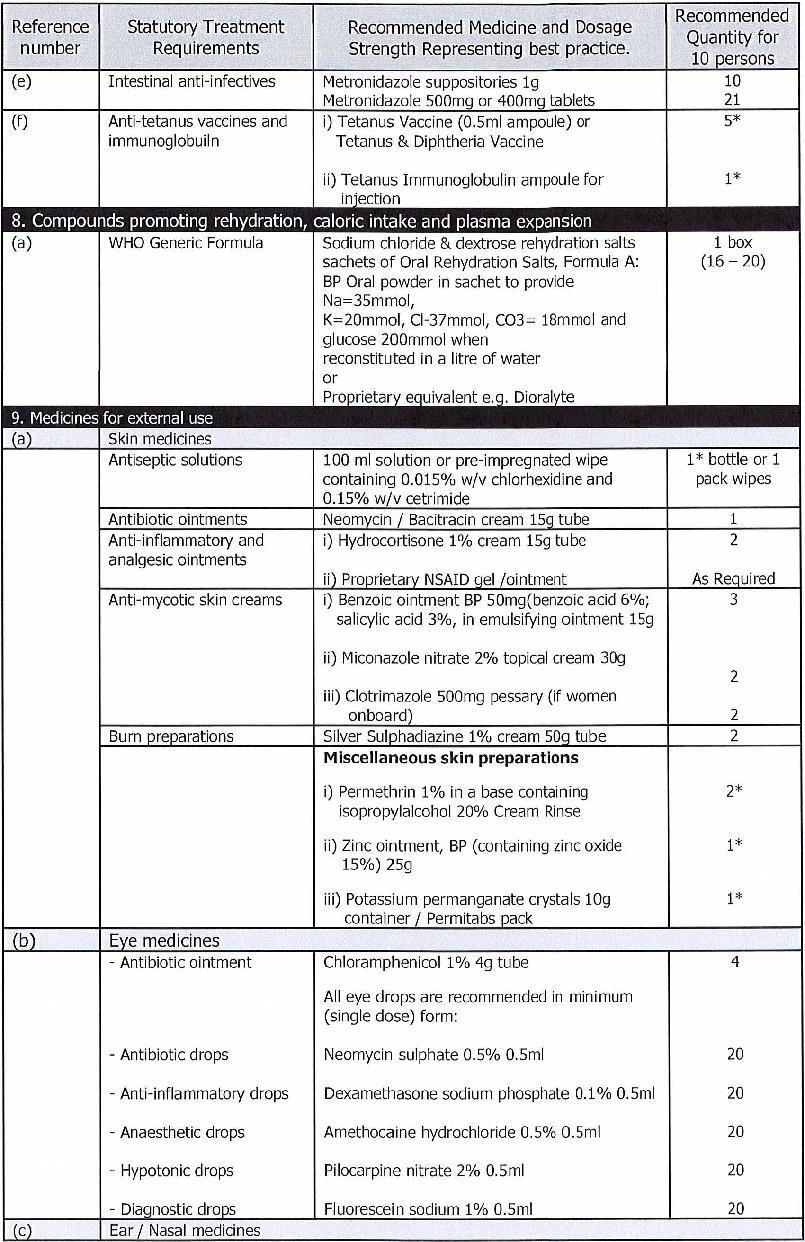
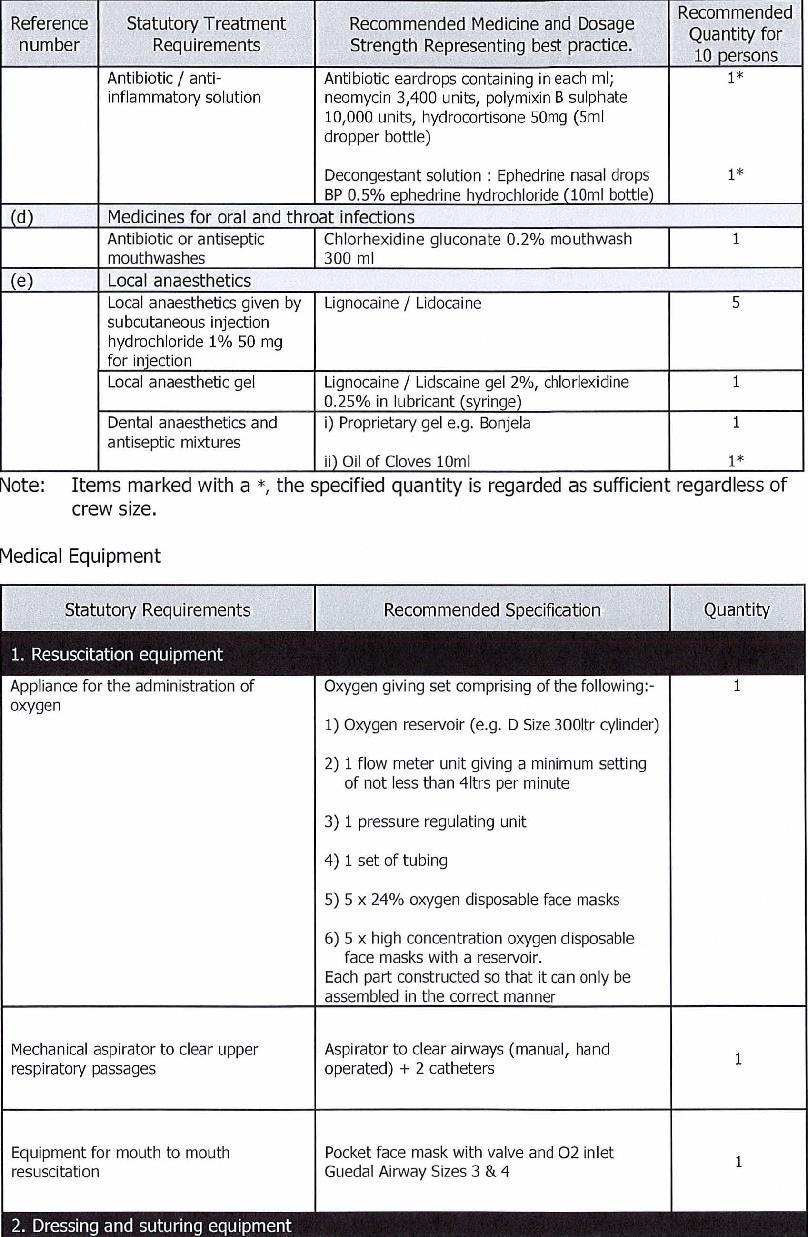
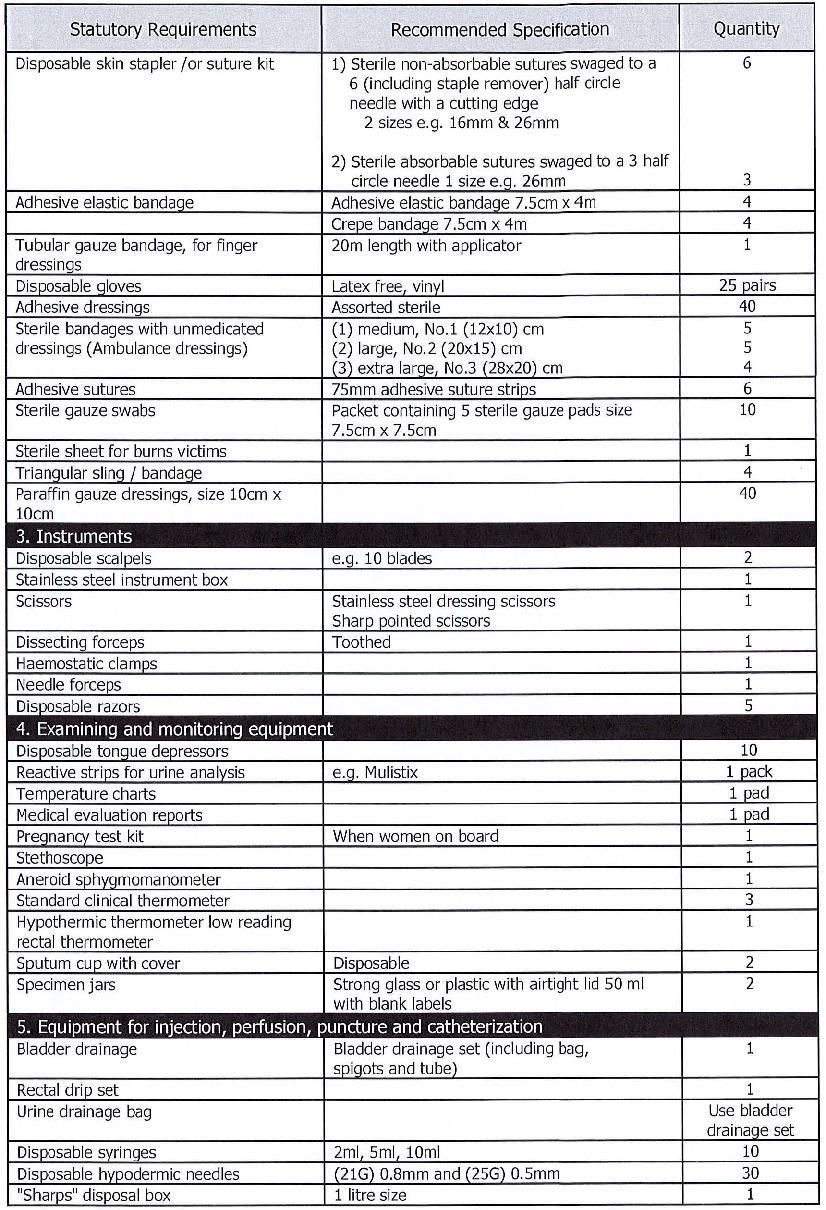
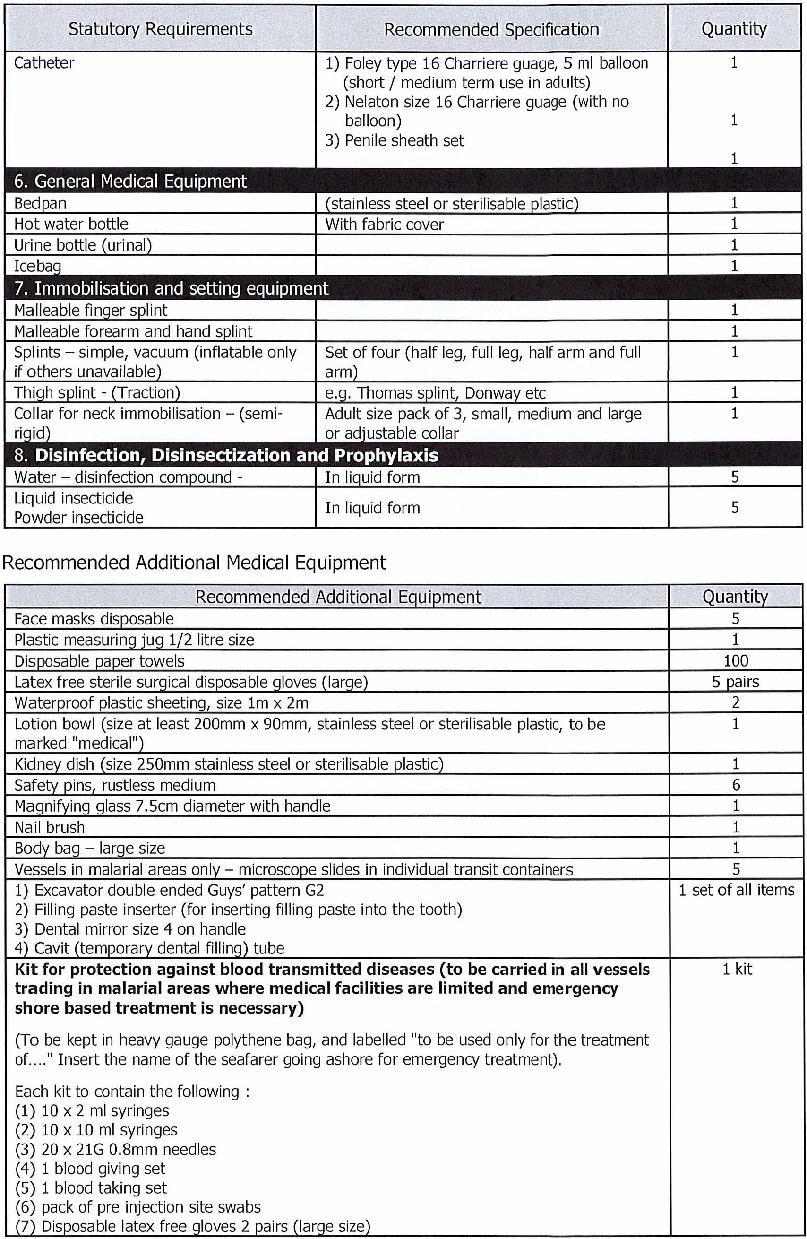


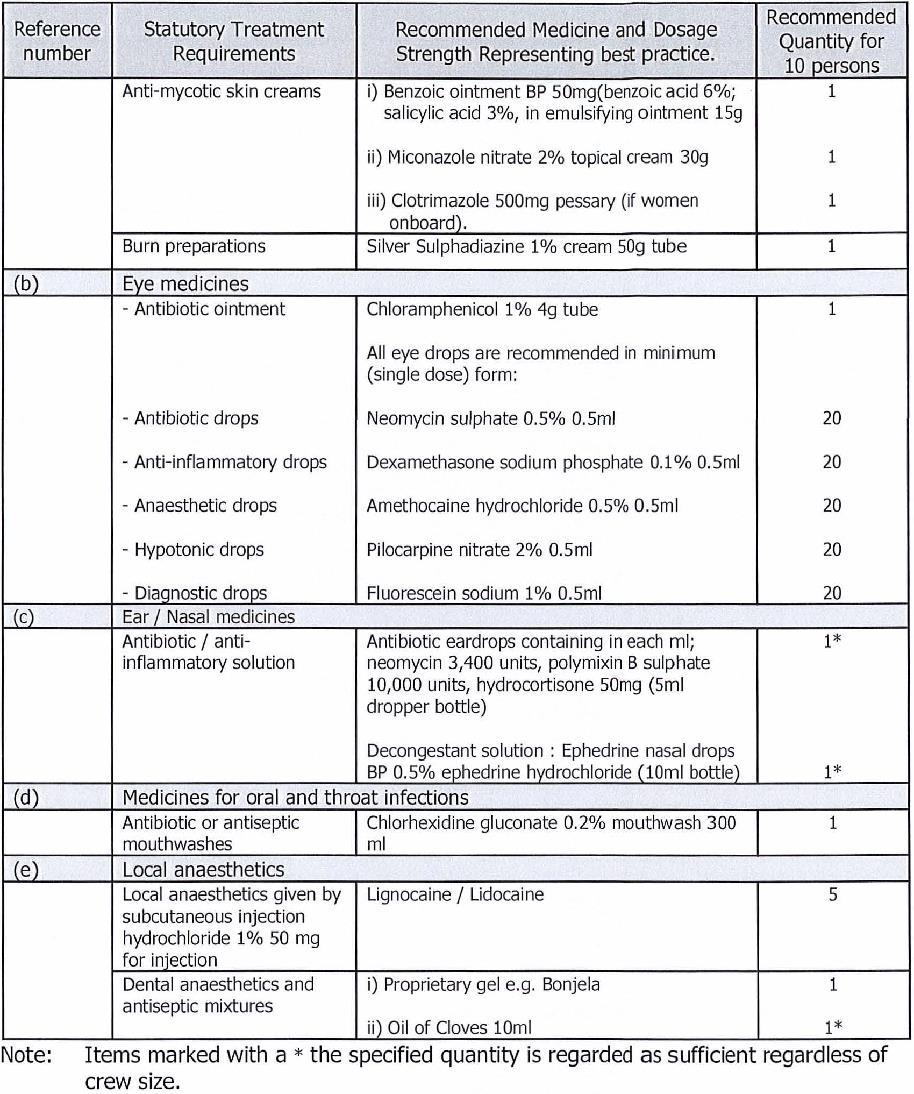
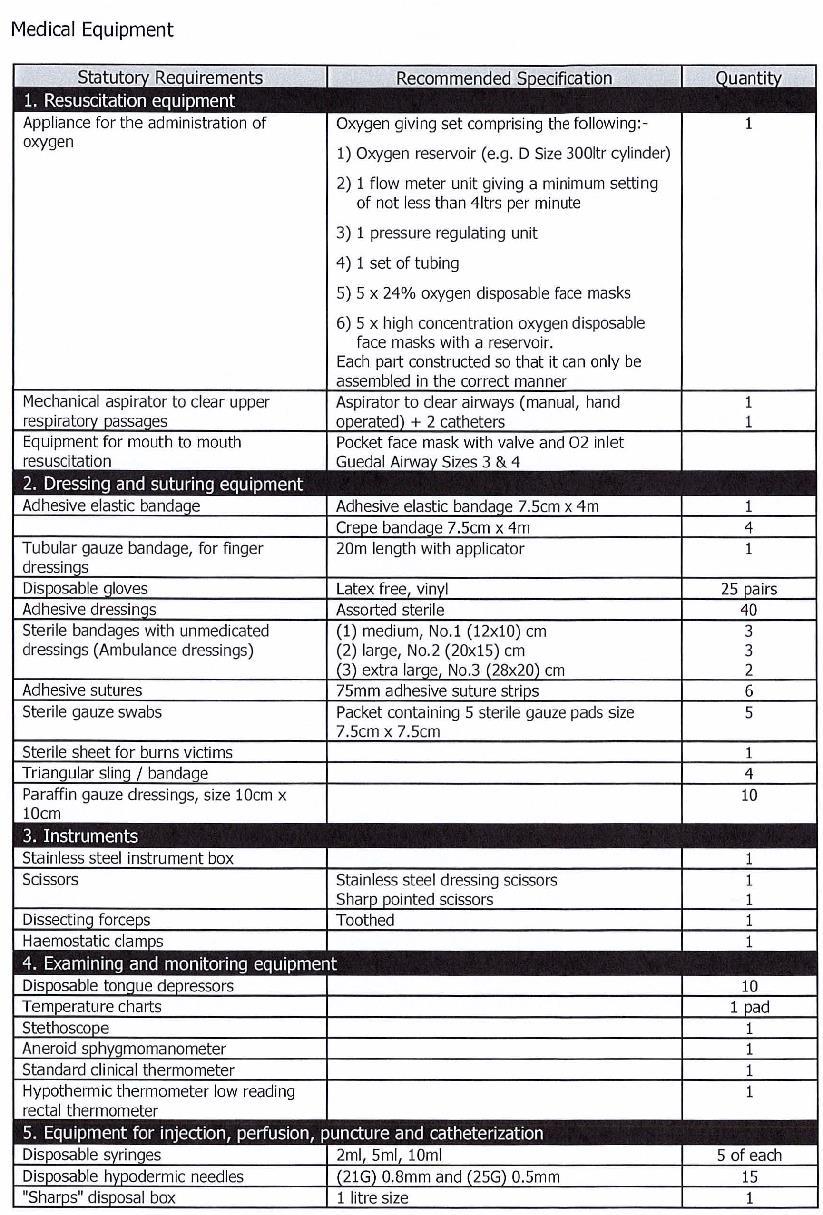


25
Shore-ship Transfer of Personnel
25.1 Tenders (Dinghies)
25.1.1 When a yacht carries a rigid or inflatable tender, it should be fit for its intended use, regularly inspected by the owner/managing agent, and maintained in a safe condition.
25.1.2 Safety equipment should be provided in the tender as appropriate to its intended range and area of operation.
25.1.3 Each tender should be clearly marked with the number of persons (mass 75 kg) that it can safely carry, and the name of the parent yacht.
25.1.4 In the case of petrol-engine tenders, see section 14 for the safety requirements for the carriage of petrol.
25.2 Helicopters
See Part C Section 1 to this Code for the safe operation of helicopters including the construction of landing areas.
25.3 Pilot for Yacht
Boarding arrangements provided for pilots should have due regard for SOLAS Chapter V, Regulation 23, the applicable IMO Resolution, International Maritime Pilots' Association (IMPA) recommendations, or any documents replacing them.
25.4 Gangways, Passerelles, and Accommodation Ladders
25.4.1 A safe means of access is to be provided at all times when in port, either deployed or available for deployment. If the safe means of access is not deployed, there shall be a means provided for communication between those on the quay and those on board.
25.4.2 When provided, gangways, passerelles, and accommodation ladders should be manufactured to a recognized national or international standard, and be clearly marked with the manufacturer's name, the model number, the maximum design angle of use and the maximum safe loading (by number of persons and by total weight). Side screens or handrail(s) should be provided on both sides, suitable to prevent individuals falling from the gangway, passerrelle or accommodation ladder.
25.4.3 Where gangways, passerelles or ladders do not comply with national or international standards, a manufacturer's test load certificate should be provided. Alternatively practical tests may be carried out to the satisfaction of the Administration. In all cases the maximum design angle, maximum number of persons, and the maximum total weight should be clearly marked, and are to be used in accordance with the manufacturer's instructions.
25.4.4 Accommodation ladders should be provided on a yacht of 120 meters in length and over.
24.4.5 Access equipment and immediate approaches to it should be adequately illuminated.
24.4.6 Reference should be made to appropriate national and international standards such as: ISO 7061:1993 - Shipbuilding - Aluminum shore gangways for seagoing yachts ISO 5488:1979 - Shipbuilding - Accommodation ladders BSMA 78: 1978 - Gangways (excluding the maximum overall widths specified in table 2) BSMA 89:1980 - Accommodation Ladders.




